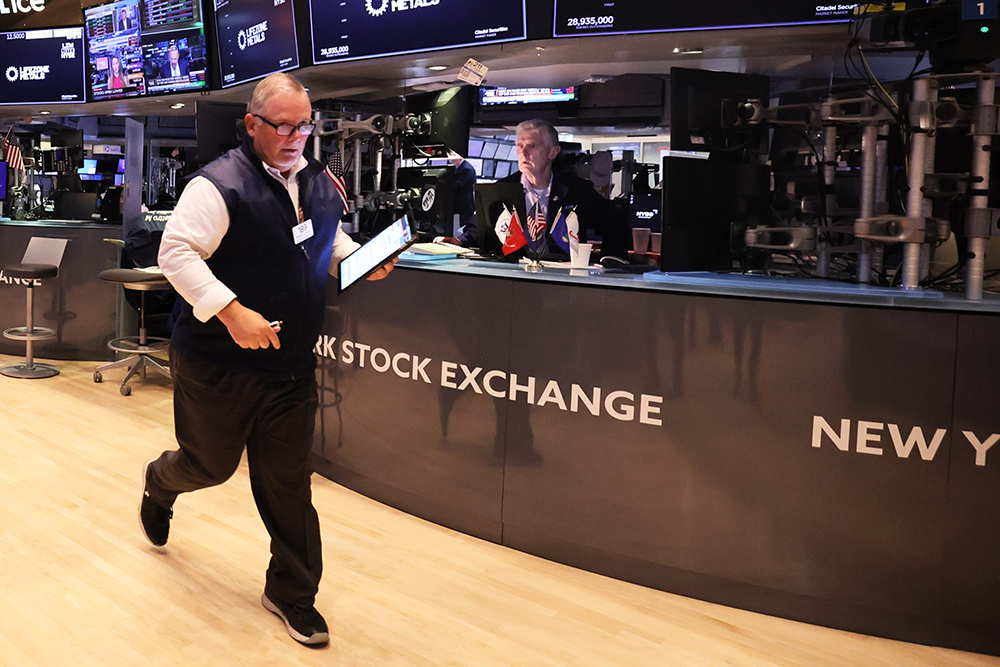
去年12月,所有討論都認為2023年將是“債券年”。在去年冬天的一兩個瞬間,這一呼聲(以及支撐它的經(jīng)濟前景黯淡的預測)似乎是正確的。
然而,如今這些聲音已經(jīng)被湮沒,因為股票需求激增推動全球股市劇烈反彈,加上有跡象表明這種漲勢可能遠未結束,使得投資者對股票優(yōu)于債券的樂觀程度比自24年前SentimentTrader模型開始對股票和債券進行比較以來的任何時候都高。
波士頓宏利資產(chǎn)管理公司(Manulife Asset Management)的全球資產(chǎn)配置主管內森·索夫特(Nathan Thooft)減少了信貸敞口,轉而增持股票,稱“隨著市場悲觀情緒、技術面不利因素和經(jīng)濟衰退風險進一步淡化,我們從減持股票轉為增持股票”。
2023年具備固定收益實現(xiàn)突破的所有條件。美聯(lián)儲(Federal Reserve)結束了大舉加息并轉向寬松政策,這本應該會帶動債券上漲,使其成為抵御經(jīng)濟增長下滑的保障措施。
結果經(jīng)濟似乎完成了一項罕見的壯舉:通脹有所緩解,同時就業(yè)實現(xiàn)增長。經(jīng)濟增速不斷加快,以致連美國央行的員工都不再預測經(jīng)濟將會衰退。目前美聯(lián)儲仍在加息,而債券并未發(fā)揮其作為安全閥的作用。
這一意外的逆轉發(fā)生后,一些著名的賣方分析師發(fā)布道歉聲明,其他人上調了他們的股票目標價,更多的人則是下調了經(jīng)濟衰退概率的預測或者完全放棄這種預測。
前一周,摩根大通(JPMorgan Chase & Co.)對客戶進行了調查,其中超過一半的人表示他們現(xiàn)在相信,盡管美國正在快速加息,美國經(jīng)濟仍會繼續(xù)擴張,即可能出現(xiàn)所謂的“軟著陸”或“不著陸”。該調查顯示,計劃減持債券以增加股票敞口的投資者數(shù)量大幅增加。
這種情況已經(jīng)發(fā)生。據(jù)德意志銀行(Deutsche Bank AG)報告,根據(jù)自身對經(jīng)濟的看法來配置資金的全權投資者加快了股票的購買速度,與2020年底疫苗發(fā)布時的速度相當。過去3個月,從流入交易所交易基金的資金看,相比固定收益類證券,投資者強烈偏好股票,而這與今年年初的情況截然相反。
馬奧尼資產(chǎn)管理公司(Mahoney Asset Management)的首席執(zhí)行官肯?馬奧尼(Ken Mahoney)表示:“這一年來,看跌的聲音響徹至今,而市場全程都在攀登憂慮之墻。我們完全可以理解他們的看法,但他們忽略了顯示股市正在走高的技術面。”
這并不是說債券今年會跑贏股票的預測完全錯誤。從整體上看,債券帶來了正回報,而且投資者能夠以承擔低風險來獲得高收益。只是今年股市出現(xiàn)了以往難以想象的漲幅——以科技股為主的納斯達克100指數(shù)(NASDAQ 100)上漲了44%——這使它們的相對表現(xiàn)顯得尤為優(yōu)異,令華爾街專業(yè)人士都出乎意料。
盡管目前軟著陸預期主導市場情緒,但這絕不是確定的。
貝萊德投資研究所(BlackRock Investment Institute)副主管亞歷克斯?布雷熱(Alex Brazier)在接受彭博電視臺(Bloomberg TV)采訪時表示:“目前市場預期經(jīng)濟將實現(xiàn)軟著陸——必須采取許多舉措才能達成這一目標,而且所有風險都朝著同一個方向。”
美聯(lián)儲加息525個基點的滯后效應可能在兩年或更久之后才會波及整個經(jīng)濟。反通貨膨脹的趨勢可能只是油價大幅下跌引起的暫時現(xiàn)象。標準普爾500指數(shù)(S&P 500)中的科技股當前市盈率為28倍,這或許意味著拋售時機已經(jīng)成熟,而倉位卻偏向上行,任何減持都可能導致更大的損失。
不過,布雷熱承認,今年到目前為止的情況并不像他和他在貝萊德的同事們預測的那樣。
他說:“市場(尤其是美國股市)上發(fā)生的一切讓許多人感到意外。”
SentimenTrader認為,這種轉變可能會持續(xù)下去。不同于過去,現(xiàn)在公司內部人員是大買家,而波動性減弱和看漲期權等技術面正在推動股市情緒持續(xù)高漲。
Sundial Capital Research和SentimenTrader分析了期貨倉位、調查結果、期權活動以及資金流動,其研究主任賈森?格普費特(Jason Goepfert)稱,另外兩次股市情緒與債市情緒差異如此之大的情形還要追溯到2003年和2009年,“那兩次都發(fā)生在曠日持久的熊市之后,并且表明投資者預期發(fā)生了巨大的轉變。兩次都緊隨著新一輪的牛市。”(財富中文網(wǎng))
——本文由科林?基廷(Colin Keatinge)、錫德?維爾馬(Sid Verma)和戴維?帕帕佐普洛斯(David Papadopoulos)協(xié)助撰寫。
譯者:中慧言-劉嘉歡
去年12月,所有討論都認為2023年將是“債券年”。在去年冬天的一兩個瞬間,這一呼聲(以及支撐它的經(jīng)濟前景黯淡的預測)似乎是正確的。
然而,如今這些聲音已經(jīng)被湮沒,因為股票需求激增推動全球股市劇烈反彈,加上有跡象表明這種漲勢可能遠未結束,使得投資者對股票優(yōu)于債券的樂觀程度比自24年前SentimentTrader模型開始對股票和債券進行比較以來的任何時候都高。
波士頓宏利資產(chǎn)管理公司(Manulife Asset Management)的全球資產(chǎn)配置主管內森·索夫特(Nathan Thooft)減少了信貸敞口,轉而增持股票,稱“隨著市場悲觀情緒、技術面不利因素和經(jīng)濟衰退風險進一步淡化,我們從減持股票轉為增持股票”。
2023年具備固定收益實現(xiàn)突破的所有條件。美聯(lián)儲(Federal Reserve)結束了大舉加息并轉向寬松政策,這本應該會帶動債券上漲,使其成為抵御經(jīng)濟增長下滑的保障措施。
結果經(jīng)濟似乎完成了一項罕見的壯舉:通脹有所緩解,同時就業(yè)實現(xiàn)增長。經(jīng)濟增速不斷加快,以致連美國央行的員工都不再預測經(jīng)濟將會衰退。目前美聯(lián)儲仍在加息,而債券并未發(fā)揮其作為安全閥的作用。
這一意外的逆轉發(fā)生后,一些著名的賣方分析師發(fā)布道歉聲明,其他人上調了他們的股票目標價,更多的人則是下調了經(jīng)濟衰退概率的預測或者完全放棄這種預測。
前一周,摩根大通(JPMorgan Chase & Co.)對客戶進行了調查,其中超過一半的人表示他們現(xiàn)在相信,盡管美國正在快速加息,美國經(jīng)濟仍會繼續(xù)擴張,即可能出現(xiàn)所謂的“軟著陸”或“不著陸”。該調查顯示,計劃減持債券以增加股票敞口的投資者數(shù)量大幅增加。
這種情況已經(jīng)發(fā)生。據(jù)德意志銀行(Deutsche Bank AG)報告,根據(jù)自身對經(jīng)濟的看法來配置資金的全權投資者加快了股票的購買速度,與2020年底疫苗發(fā)布時的速度相當。過去3個月,從流入交易所交易基金的資金看,相比固定收益類證券,投資者強烈偏好股票,而這與今年年初的情況截然相反。
馬奧尼資產(chǎn)管理公司(Mahoney Asset Management)的首席執(zhí)行官肯?馬奧尼(Ken Mahoney)表示:“這一年來,看跌的聲音響徹至今,而市場全程都在攀登憂慮之墻。我們完全可以理解他們的看法,但他們忽略了顯示股市正在走高的技術面。”
這并不是說債券今年會跑贏股票的預測完全錯誤。從整體上看,債券帶來了正回報,而且投資者能夠以承擔低風險來獲得高收益。只是今年股市出現(xiàn)了以往難以想象的漲幅——以科技股為主的納斯達克100指數(shù)(NASDAQ 100)上漲了44%——這使它們的相對表現(xiàn)顯得尤為優(yōu)異,令華爾街專業(yè)人士都出乎意料。
盡管目前軟著陸預期主導市場情緒,但這絕不是確定的。
貝萊德投資研究所(BlackRock Investment Institute)副主管亞歷克斯?布雷熱(Alex Brazier)在接受彭博電視臺(Bloomberg TV)采訪時表示:“目前市場預期經(jīng)濟將實現(xiàn)軟著陸——必須采取許多舉措才能達成這一目標,而且所有風險都朝著同一個方向。”
美聯(lián)儲加息525個基點的滯后效應可能在兩年或更久之后才會波及整個經(jīng)濟。反通貨膨脹的趨勢可能只是油價大幅下跌引起的暫時現(xiàn)象。標準普爾500指數(shù)(S&P 500)中的科技股當前市盈率為28倍,這或許意味著拋售時機已經(jīng)成熟,而倉位卻偏向上行,任何減持都可能導致更大的損失。
不過,布雷熱承認,今年到目前為止的情況并不像他和他在貝萊德的同事們預測的那樣。
他說:“市場(尤其是美國股市)上發(fā)生的一切讓許多人感到意外。”
SentimenTrader認為,這種轉變可能會持續(xù)下去。不同于過去,現(xiàn)在公司內部人員是大買家,而波動性減弱和看漲期權等技術面正在推動股市情緒持續(xù)高漲。
Sundial Capital Research和SentimenTrader分析了期貨倉位、調查結果、期權活動以及資金流動,其研究主任賈森?格普費特(Jason Goepfert)稱,另外兩次股市情緒與債市情緒差異如此之大的情形還要追溯到2003年和2009年,“那兩次都發(fā)生在曠日持久的熊市之后,并且表明投資者預期發(fā)生了巨大的轉變。兩次都緊隨著新一輪的牛市。”(財富中文網(wǎng))
——本文由科林?基廷(Colin Keatinge)、錫德?維爾馬(Sid Verma)和戴維?帕帕佐普洛斯(David Papadopoulos)協(xié)助撰寫。
譯者:中慧言-劉嘉歡
All the chatter back in December was that 2023 was to be the “year of the bond.” And for a brief moment or two in the winter, that call — and the economic doom-and-gloom that underpinned it — looked right.
It is now being overrun, though, by an avalanche of demand for equities that has unleashed a furious rally across the globe and, in a sign the gains are likely far from over, made investors more optimistic about stocks relative to bonds than at any point since SentimenTrader models began comparing them 24 years ago.
“As sentiment, technicals and risk of the recession got pushed further out we moved from being underweight stocks to overweight,” said Nathan Thooft, global head of asset allocation at Manulife Asset Management in Boston, who’s reduced his credit exposure in favor of an equity overweight.
2023 had all the makings of a breakout year for fixed income. The end of aggressive Federal Reserve rate hikes and a pivot to easier policy should have set up a rally in bonds and made them an insurance policy against a growth downturn.
Instead, the economy seems to have pulled off a rare feat: inflation has slowed while new jobs are being created. Growth keeps accelerating and even staff at the US central bank are no longer forecasting a recession. The Fed is still raising rates — though it may have just completed its last increase this week — and bonds aren’t living up their billing as a safety valve.
The surprising reversal has found some prominent sell-side strategists issuing mea culpas, others upgrading their stock targets, and more downgrading their recession forecasts or giving them up altogether.
More than half of clients surveyed last week by JPMorgan Chase & Co. say they are now convinced the US economy can continue to expand despite rapid-fire hikes, so-called “soft” or “no landing” scenarios. The survey shows a jump in the number of investors planning to boost equity exposure at the expense of bonds.
That’s already happening. Discretionary investors — who allocate cash based on their view of the economy — have ramped up their pace of stocks buying on par with the time of the vaccine announcement in late 2020, according to Deutsche Bank AG. Flows into exchange-traded funds show a strong preference for equities over fixed income in the last three months, a big reversal from the start of the year.
“The bears were loud all year and still are and meanwhile the market climbed the wall of worry perfectly the entire time,” said Ken Mahoney, chief executive officer of Mahoney Asset Management. “We definitely can understand their point of view. But they are missing out on the technicals that have been telling us stocks are working their way higher.”
It’s not like predictions that bonds would win this year have been entirely wrong — across the curve they’ve posted positive returns and investors are collecting big yields for little risk. It’s just that equities have posted once-unimaginable gains this year — the tech-heavy Nasdaq 100 is up 44% — that’s juiced their relative performance in ways that have blindsided Wall Street pros.
And while the soft-landing scenario is now the market’s favorite, it’s by no means certain.
“What the market’s now pricing is a soft landing — a lot has to go right for that, and the risks are in one direction,” Alex Brazier, deputy head of BlackRock Investment Institute, said in an interview with Bloomberg TV.
The lagged effect of 525 basis points of Fed rate hikes could take two years or more to ripple through the economy. The disinflation trend might be a blip that owes too much to falling oil prices. Tech stocks in the S&P 500 trading at 28 times prospective earnings may mean they are ripe for a selloff while positioning is so skewed to the upside, any pullback risks a bigger fall.
Still, Brazier admitted this year so far isn’t turning out like he and his BlackRock colleagues anticipated.
“What’s happened, particularly in the US stock market, has taken a lot of people by surprise,” he said.
SentimenTrader suggests the shift may endure. Unlike in the past, corporate insiders are big buyers, while technicals like subdued volatility and bullish options are keeping equity sentiment elevated.
The only other two instances when stocks versus bond sentiment were so wide apart were in 2003 and 2009 “both coming out of protracted bear markets and indicating a dramatic shift in investor expectations,” said Jason Goepfert, director of research at Sundial Capital Research and SentimenTrader, which analyzes futures positioning, surveys, options activity and fund flows. “Both preceded new bull markets.”
–With assistance from Colin Keatinge, Sid Verma and David Papadopoulos.






